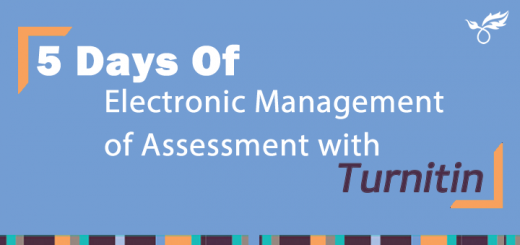Moodle Monday: Case Study – Moodle Workshop Activity for Peer Assessment
Welcome back to Moodle Mondays for 2017! This Moodle Monday post also includes a case study from Dr Sam Yoward in Physiotherapy on the use of Moodle’s Workshop activity for peer assessment.
The workshop activity enables the collection, review and peer assessment of students’ work. Students submit work to the Workshop submission point and, after the deadline date, the work is allocated to the students for marking. This can be set to randomly allocate or you can manually choose which pieces of work are allocated to each student.
Students can obtain two grades in a workshop activity – a grade for their submission and a grade for their assessment of their peers’ submissions. Both grades are recorded in the gradebook. However, you don’t necessarily need to use this tool for work that is ‘graded’ with numerical grades and can use it for qualitative feedback comments, in the same way that it was used in the Physiotherapy case study below. Tutors can also mark the work after the peer assessment process has taken place.
The Workshop activity can be used in conjunction with the 3E element of the TEL Quality Framework to either Enhance, Extend or Empower learners.
- Enhance – Adopting technology in simple and effective ways to actively support students and increase their activity and self-responsibility.
- Extend – Further use of technology that facilitates key aspects of students’ individual and collaborative learning and assessment through increasing their choice and control.
- Empower – Developed use of technology that requires higher order individual and collaborative learning that reflect how knowledge is created and used in professional environment.
Peer assessment is a good way to generate timely feedback on formative work and can encourage ‘deep learning’ from the discussions that take place. It is likely that students are already taking part in peer and self assessment informally outside the classroom, but building this kind of activity into a module can enhance the learning experience and expose students to some good (and maybe not so good) practice in relation to written assessment.
For instructions on how to set up the Workshop Activity in Moodle, see the Moodle Docs help pages.
Case Study
Dr Sam Yoward in Physiotherapy used the Workshop Activity as part of the Professional Development module for first year Physiotherapy students. The case study below is written from Sam’s perspective and we would like to thank Sam for agreeing to contribute to this post during what is always a busy time for academic staff.
What did you want to achieve?
This particular activity was for a formative assessment and I wanted the students to have the opportunity of submitting via Moodle a brief written piece of work so that they felt prepared for the practicalities of submitting their summative assessment. I also wanted the students to receive feedback on their writing in a formative way, prior to their summative, so that they could get a sense of what was expected at this level of education, as level 1, semester 1 students. Finally, I wanted the students to offer peer feedback so that they could learn from the positives and negatives of each other’s work and also to delve a bit deeper into the detail of the assessment itself, engaging in discussion over the work with a fellow marker.
How did the technology help you facilitate what you wanted to achieve?
The technology allowed the work to be submitted in the same way that the summative assessment would be submitted, from the students’ point of view. It then randomly allocated one student’s work to another student so that when they logged into Moodle each could see the submission of another student, anonymously. Students were then able to work in pairs on two pieces of work (one for each person within the pair) and offered feedback via downloading the documents and using the comments feature in Word. Finally, the students uploaded the ‘marked’ assignments back to Moodle and were able to see their own work with feedback comments too.
Did it work?
The students find it a valuable exercise on lots of levels: preparing written assignment work when new to higher education in a ‘safe’ environment, in that there are no marks attached to the activity; familiarisation with referencing work; seeing others’ assignments to work out what works well and what is not so good; practising uploading material to Moodle before the deadline of the actual summative assessment; being allocated anonymous work so that they don’t feel under pressure with who is seeing their work; offering feedback that is not anonymous, so having to ‘own’ their comments therefore improving the quality of comments ensuring they are constructive.
Things to note
We have used this workshop facility before and it is always a good learning experience, although there are some things to be aware of. For example, this year, for the first time, some students had duplicate email addresses logged to Moodle which was originally done to get over the access problems early in the semester whilst waiting for registration to occur. This meant that some students appeared as two people and the technology allocated them accordingly which made for a trying time on the workshop feedback time, although Rosie was able to provide technical support and overcome the issue.
Also of note, is that coincidentally, a pair of students working together to offer feedback can find that they have been allocated each other’s work – this isn’t a big problem but requires that the students check as soon as they log on so that they can move to a different pair before they start working on the assessment in earnest. We had an additional hitch in that two students received the wrong feedback by mistake, but again, Rosie was able to ensure that their correct work was loaded and we had to ask the relevant students to disregard the work that wasn’t theirs.
I specifically wanted the work being marked to be anonymous to those assessing and students were asked not to put on any identifying information, although some still chose to put their name or number at the top of the document. It’s also worth reminding students to remember to delete the work from their own documents once they have uploaded the feedback to Moodle.
Based on past feedback, tutors also offered feedback on the work so that each student had feedback from two students plus a tutor. Although they were only 500 word documents this still substantially added to the workload. We also have to ‘double teach’ the session, due to the size of our cohort vs the size of computer rooms on campus, so this is something to consider when attempting to run this kind of activity. One option could be to run this activity wholly online and ask students to complete it in their own time, although this would mean that any technical hitches would have to wait until the following day.
Final thoughts
My final word of advice is to plan what you will do if a student doesn’t attend as this would affect the timeliness of another student receiving their feedback. I haven’t found this to be a big problem, but I tell students in advance that the onus is on them to do the work whether they turn up or not, out of fairness to their peers, and that it is easier to do as a pair, with technical support on hand than to try and work alone at home. This means that I usually tell students that there will potentially be a couple of days before the work is released to account for illness etc. but if everyone is there on the day then the work can be released immediately. This is great for quick feedback as they have usually only handed it in a day or two before they work on it and receive feedback. I’d recommend technical support in setting up the workshop activity and in carrying out the feedback.
Are you using Moodle’s Workshop Activity or another method of peer assessment in the classroom? Can you see opportunities for using this method if you haven’t already? Let us know in the comments below! Visit the Moodle Docs help pages for instructions on setting up the Workshop Activity.
If you would like to contribute to a case study please get in touch with us at tel@yorksj.ac.uk.
References
- Race, P. (2001). The Lecturer’s Toolkit. London. Kogan Page, pp. 94-95.
- Brown, S. Rust, C. & Gibbs, G. 1994. Strategies for Diversifying Assessment in Higher Education. The Oxford Centre for Staff Development, Oxford. Oxonion Rewley Press.
- Falchikov, N. (2007). In: Rethinking Assessment in Higher Education (Boud, D. & Falchikov, N., eds.), pp. 128-144. Abingdon. Routledge.
- Hughes, I E (1995) Peer assessment of student practical reports and its influence on learning and skill acquisition. Capability, 1, 39-43

